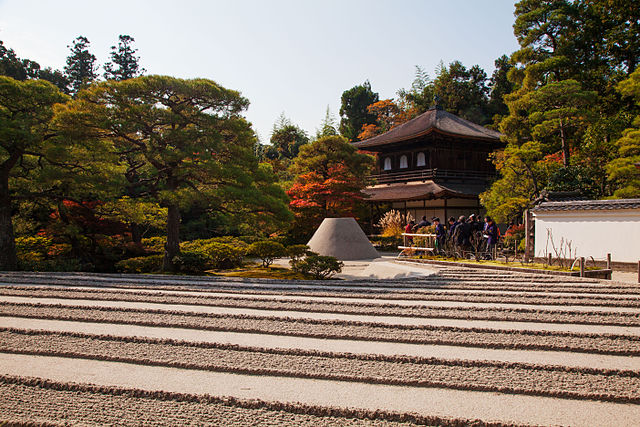|
Located in the foothills on the east side of Kyoto, Ginkaku-ji "Jisho-ji" is famous for its two-story Kannon Hall, the Silver Pavilion, which takes its name from the anecdote that Shogun Ashikaga Yoshimasa, the temple's patron, intended to cover the pavilion with silver leaf in imitation of the Golden Pavilion Kinkakuji built by his grandfather.
Unlike its counterpart, however, the Ginkaku-ji was never actually covered in silver; only the name had been applied before the plans fell apart. |
|
Much like its golden counterpart Kinkakuji, the Silver Pavilion is often choked with tourists, shuffling past a meticulously-maintained dry landscape Zen garden and the surrounding moss garden, before posing for pictures in front of the Pavilion across a pond.
Although it's considered a temple today it was originally a retirement villa surrounded by an exquisite walking garden that includes a famous Japanese dry sand garden. |
|
Today, Ginkakuji consists of the Silver Pavilion, Togu-do, a beautiful moss garden, a sand garden and half a dozen other temple buildings. Beyond sand, the garden is surrounded by a bamboo forest.
Ginkaku-ji a UNESCO World Heritage Site is one of the city's most popular sites, and it is almost always crowded, especially during spring and autumn. The best time to go is right when the place opens or just before it closes. |
|
Ginkaku-ji is at the northern end of the Philosopher's Path.
The Philosopher's Path "Tetsugaku-no-michi" is a pedestrian path approximately 2 kilometers long that follows a cherry-tree-lined canal in Kyoto’s Higashiyama district, between Ginkaku-ji and Nanzen-ji. It passes a number of temples and shrines and takes about 30 minutes to complete the walk, although many people spend more time visiting the sights along the way. |
Ginkaku-Ji AccessBus: From Kyoto Station take the bus number 5, 17 or Raku Bus 100 to Ginkaku-ji-michi Bus Stop "takes about 35 minutes".
And from there it is 10 minutes’ walk to the Temple. |
Ginkaku-Ji - Sakyo-ku, Kyoto-shi, Kyoto Prefecture











